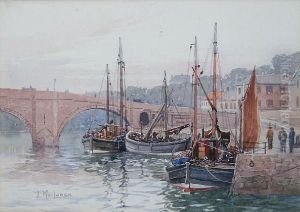James MacLaren Paintings
James MacLaren was a Scottish architect who played a significant role in the development of the Scottish architectural style in the late 19th century, often associated with the Arts and Crafts Movement. Born in 1853 in Scotland, MacLaren demonstrated an early interest in architecture, and this passion guided his career path.
After completing his architectural education, MacLaren began his professional journey. He worked for a time in the office of John Burnet, a prominent Glasgow architect, where he honed his skills and developed his architectural philosophy. MacLaren was influenced by the Arts and Crafts Movement, which emphasized handcraftsmanship, simplicity of form, and the use of local materials. This movement was a reaction against the industrialization of the time, which many felt was leading to a decline in traditional skills and design quality.
In his own practice, MacLaren focused on incorporating traditional Scottish elements into his designs while also ensuring that his buildings met the needs of modern life. His work was characterized by its attention to detail, use of high-quality materials, and the integration of finely crafted metalwork and woodwork.
Unfortunately, James MacLaren's career was cut short by his untimely death in 1890 at the age of 37. Despite his brief career, MacLaren's work had a lasting impact on Scottish architecture. His designs influenced a generation of architects and contributed to the resurgence of interest in traditional Scottish architectural forms at a time when the country was grappling with rapid modernization and urbanization.
Though not as widely known as some of his contemporaries, MacLaren's legacy can be seen in the buildings he left behind and in the continued appreciation for the Arts and Crafts Movement in Scotland. His approach to design, which balanced a respect for tradition with the necessities of modern life, continues to be relevant in discussions of sustainable and contextually sensitive architecture.



